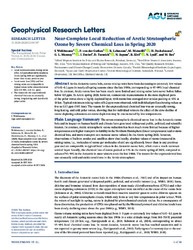Near-Complete Local Reduction of Arctic Stratospheric Ozone by Severe Chemical Loss in Spring 2020
Lehmann, R.
Davies, J.
Jepsen, N.
Lyall, N.
Rex, M.
DOI: https://doi.org/10.1029/2020GL089547
Persistent URL: http://resolver.sub.uni-goettingen.de/purl?gldocs-11858/9326
Persistent URL: http://resolver.sub.uni-goettingen.de/purl?gldocs-11858/9326
Wohltmann, I.; von der Gathen, P.; Lehmann, R.; Maturilli, M.; Deckelmann, H.; Manney, G. L.; Davies, J.; Tarasick, D.; Jepsen, N.; Kivi, R.; Lyall, N.; Rex, M., 2020: Near-Complete Local Reduction of Arctic Stratospheric Ozone by Severe Chemical Loss in Spring 2020. In: Geophysical Research Letters, Band 47, 20, DOI: 10.1029/2020GL089547.
 |
Dokument öffnen: |
In the Antarctic ozone hole, ozone mixing ratios have been decreasing to extremely low values of 0.01–0.1 ppm in nearly all spring seasons since the late 1980s, corresponding to 95–99% local chemical loss. In contrast, Arctic ozone loss has been much more limited and mixing ratios have never before fallen below 0.5 ppm. In Arctic spring 2020, however, ozonesonde measurements in the most depleted parts of the polar vortex show a highly depleted layer, with ozone loss averaged over sondes peaking at 93% at 18 km. Typical minimum mixing ratios of 0.2 ppm were observed, with individual profiles showing values as low as 0.13 ppm (96% loss). The reason for the unprecedented chemical loss was an unusually strong, long-lasting, and cold polar vortex, showing that for individual winters the effect of the slow decline of ozone-depleting substances on ozone depletion may be counteracted by low temperatures.
Statistik:
ZugriffsstatistikSammlung:
This is an open access article under the terms of the Creative Commons Attribution-NonCommercial-NoDerivs License, which permits use and distribution in any medium, provided the original work is properly cited, the use is non-commercial and no modifications or adaptations are made.

